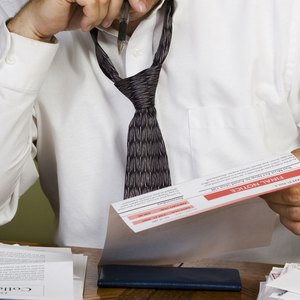
When individuals or companies file bankruptcy, it’s typically because they don’t have enough money to pay off all of the creditors in full. As a result, part of the bankruptcy proceeding is to determine how much each creditor receives. However, not all creditors are treated the same in bankruptcy. Some creditors have the right to be paid before others, either because they have a security interest in a specific asset or because they have priority to be paid before other creditors. When there is not enough to pay multiple creditors with equal priority, you must calculate the pro-rata share for each creditor.
Tips
In order to calculate the pro-rate share for a creditor, you must first calculate the percentage of total debt that can be repaid with available funds and then use that percentage to allocate each creditors portion of debt repayment relative to the sum total they were originally owed.
Defining Secured Creditors
Secured creditors are creditors who are owed money that is secured by a specific piece of property, such as real estate, cars or other assets. The secured creditors are entitled to the proceeds from the asset securing the debt, and any excess debt is then an unsecured claim. For example, say you owe your bank $15,000 on an auto loan, but the car will only sell for $10,000. Your bank has a $10,000 secured claim and a $5,000 unsecured claim.
Priority Unsecured Claims
Some unsecured claims are given higher priority for getting paid in bankruptcy than others. Examples of priority unsecured claims include alimony, certain tax debts, child support and certain wrongful death damages, such as if you killed someone while driving drunk. These unsecured debts are paid before other unsecured claims, and any portion that isn’t paid isn’t eliminated through the bankruptcy process.
For example, say you owe $2,000 in child support and $12,000 in credit card debt. If the amount of money available for unsecured creditors is $5,000, the child support claim would be paid in full, and the remaining $3,000 would be divided among the remaining unsecured creditors. However, if you only had $1,500 available for unsecured creditors, the entire amount would be distributed to pay the child support, you would still owe $500 in child support, and there would be no money available to pay the other unsecured creditors.
Calculating Pro-Rata Shares
After all of the secured creditors and priority unsecured creditors are paid, the remaining funds are divided among the nonpriority unsecured creditors pro rata. To calculate what each creditor will receive, first add up all of the remaining unsecured debts. Second, divide the total amount available for creditors by the total amount of unsecured debt to find the portion of debt that will be paid. Finally, multiply that portion by each creditor’s debt to calculate what that creditor will receive.
For example, say there are three unsecured creditors owed $2,000, $3,000 and $5,000, but there is only $1,000 available to pay them. First, add $2,000, $3,000 and $5,000 to find the total unsecured debt equals $10,000. Second, divide $1,000 by $10,000 to find 0.1, or 10 percent, of each creditor’s debt will be paid. Finally, multiply 0.1 by $2,000, $3,000 and $5,000 to find that the creditors will receive $200, $300 and $500 each.
References
- Nolo: Types of Creditor Claims in Bankruptcy: Secured, Unsecured & Priority
- Nolo: Understanding Secured, Unsecured & Priority Claims in Bankruptcy
- PRORATE | definition in the Cambridge English Dictionary
- Govinfo. "11 U.S.C. 507," Pages 109-111. Accessed March 22, 2020.
- United States Courts. "Chapter 11 - Bankruptcy Basics." Accessed March 22, 2020.
- Kirkland & Ellis. "Chapter 11-“101.” Accessed March 22, 2020.
- U.S. Securities & Exchange Commission. "Bankruptcy: What Happens When Public Companies Go Bankrupt." Accessed March 22, 2020.
Writer Bio
Based in the Kansas City area, Mike specializes in personal finance and business topics. He has been writing since 2009 and has been published by "Quicken," "TurboTax," and "The Motley Fool."

